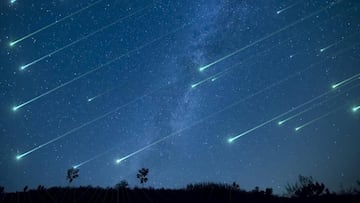Lyrids meteor shower 2021: dates, times and how to see in the US
An annual meteorological phenomenon will be streaking across the skies this month. Here's when and where to catch a glimpse of the Lyrids meteor showers.


Every year the Lyrid meteor shower is visible in the night sky and is usually the cosmic event that breaks the so-called ‘meteor draught’ that typically occurs from January to April.
This year the Lyrids are expected to reach their peak on the night of 21-22 April, with around 10 meteors per hour visible streaking across clear skies. This is the typical peak but some years has seen huge surges with as many as 100 meteors per hour.
If you are lucky enough to have clear skies at night you may be able to catch the show for yourself. Here’s everything you need to know about the Lyrid meteor shower.
When and where will the Lyrid shower be visible this year?
Experts are expecting the peak of the Lyrids meteor shower to be visible on Wednesday night, but the spectacle will actually continue for over a week. The Lyrids are typically active from roughly 16 – 25 April. This year, they should be visible on Earth from Monday 19 April onwards.
Lyrid meteors face off against a bright moon this week https://t.co/r1zk7s6KJY pic.twitter.com/EkPAqHHx12
— SPACE.com (@SPACEdotcom) April 18, 2021
With only between 10-15 meteors per hour at the peak you will need to hope for clear skies to see the shower, but they should be visible anywhere on earth. This year the new moon will arrive on 12 April so you will have the best chance of watching the meteor show between moonset and dawn.
To find out what time that means where you are, you can check out the moon’s setting time in your sky on TimeandDate.
What to look for if you’re viewing the Lyrid shower
If you are desperate to get the best look at this annual occurrence it may help to learn a bit more about the shower’s radiant point, which marks the central spot from which the shower emanates. The meteors tend to stem from the constellation Lyra the Harp, which is where the shower gets its name.
For the first time in nearly four months, skywatchers of all ages will have the opportunity to spot some shooting stars as the Lyrid meteor shower takes center stage on the night of April 21: https://t.co/cnPV3AzAKd pic.twitter.com/2AIny6uisu
— Breaking Weather by AccuWeather (@breakingweather) April 18, 2021
Related stories
Typically the meteor shower starts when the radiant point is on the rise, meaning a start time of around 10pm local time for those in the Northern hemisphere. From there it rises in the sky and gets fairly high by midnight, but will not reach the highest point until just before dawn.
If you don’t fancy the late night option, you may still be able to see signs of the Lyrid shower in the evening. Typically the meteors on show then are termed ‘earth-grazers’, which are slow-moving but long-lasting as they drift across the sky.